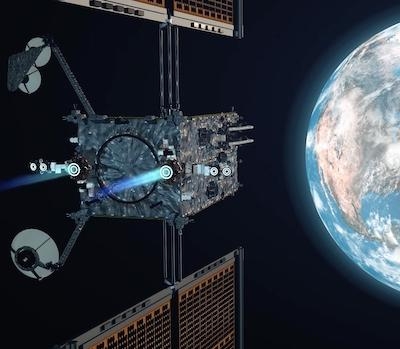Partners With Blue Origin And Draper To Design, Build And Demonstrate Operations Of A Spacecraft That Could Support Returning Humans To The Surface Of The Moon By 2024
Maxar Technologies has been selected by NASA to build and perform a spaceflight demonstration of the lunar Gateway’s power and propulsion element spacecraft. Blue Origin and Draper will join the Maxar-led team in designing, building and operating the spacecraft through the demonstration period. The power and propulsion element is a key component to NASA’s overall plans to land American astronauts on the surface of the Moon by 2024, and will be the first segment of the Gateway tested in space.

Maxar previously conducted a four-month study to develop affordable and innovative electric-propulsion-enabled concepts for the power and propulsion element spacecraft. Building on the successful completion of the study, Maxar has been selected to proceed with development. The power and propulsion element will provide power, maneuvering, attitude control, communications systems and initial docking capabilities. Maxar is currently targeting launch of the element on a commercial rocket by late 2022.
“Maxar Space Solutions is proud to play a critical role in enabling American astronauts to build a sustainable presence on the Moon. Our power and propulsion element partnership enables NASA to leverage Maxar’s commercial capabilities to cost-effectively expedite plans for sustainable exploration of the Moon, while also providing significant benefits to American industry,” said Dan Jablonsky, Maxar CEO. “As a valuable part of Maxar, our Space Solutions group serves the global commercial and U.S. government satellite market.”
This firm-fixed price award includes an indefinite-delivery/indefinite-quantity portion and carries a maximum total value of $375 million. Following a successful demonstration period of up to one-year, NASA could acquire the spacecraft for use as the first element of the Gateway.
“The Gateway will give us a strategic presence on and around the Moon. It will drive our activity with commercial and international partners and help us explore the entire lunar surface and its resources,” said William Gerstenmaier, associate administrator, Human Exploration and Operations Mission Directorate at NASA Headquarters in Washington. “We will ultimately translate that experience toward human missions to Mars.”
Maxar’s power and propulsion element design is based on our powerful 1300-class platform, which provides flexibility for a broad range of applications and technological advances. There are 91 spacecraft based on the 1300 currently on orbit for commercial operators – more than any other model of communications satellite. Maxar’s 1300-class spacecraft platform is also the basis for NASA’s Psyche mission, which will explore an all-metal asteroid beyond Mars in 2026, and NASA’s Restore-L spacecraft, which will refuel the Landsat-7 satellite in 2022.
High-power solar electric propulsion will be used to efficiently maneuver the power and propulsion element into its orbit and subsequently move the Gateway between lunar orbits over its lifetime to maximize NASA’s science and exploration operations. Maxar’s extensive experience with solar electric propulsion includes 36 spacecraft on-orbit today and more than 100,000 hours of firing time.
A key element of Maxar’s power and propulsion element design is the Roll Out Solar Array (ROSA). ROSA is a groundbreaking, compact, modular and scalable solar array system that rolls up for launch instead of folding like an accordion. ROSA is a highly mass-efficient, qualified technology that can be scaled up to 200kW and above for high-power operations. ROSA was successfully tested on the International Space Station in 2017 and is available for use on all of Maxar’s spacecraft platforms.
The operations of DigitalGlobe, SSL (Space Systems Loral) and Radiant Solutions were unified under the Maxar brand in February; MDA continues to operate as an independent business unit within the Maxar organization.
(Image provided with Maxar news release)
 ANN's Daily Aero-Term (05.02.24): Touchdown Zone Lighting
ANN's Daily Aero-Term (05.02.24): Touchdown Zone Lighting Aero-News: Quote of the Day (05.02.24)
Aero-News: Quote of the Day (05.02.24) Aero-News: Quote of the Day (05.03.24)
Aero-News: Quote of the Day (05.03.24) ANN's Daily Aero-Term (05.03.24): UAS Traffic Management (UTM)
ANN's Daily Aero-Term (05.03.24): UAS Traffic Management (UTM) ANN's Daily Aero-Linx (05.03.24)
ANN's Daily Aero-Linx (05.03.24)



